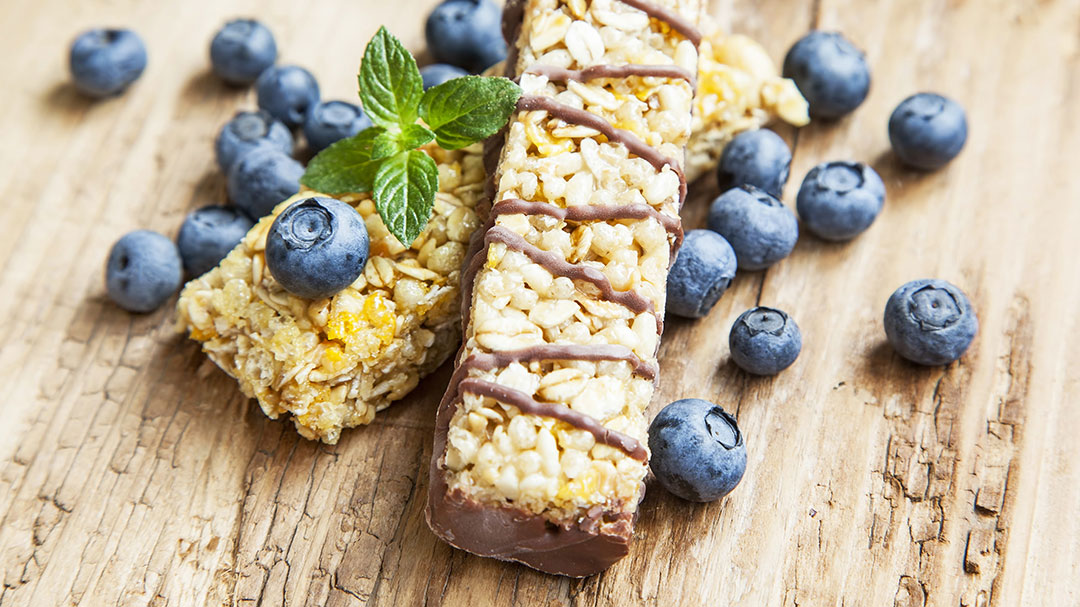Health Food Fakes
September 1, 2008

Our supermarkets contain thousands of foods with all sorts of nutritional claims and promotional phrases, designed to sing the praises of various products and grab your attention. Among the hype and mixed messages are a number of foods promoted as healthy that are generally thought a good choice. But a closer look at the finer print reveals a different story.
1. Breakfast cereal bars
Breakfast cereal bars are promoted as a quick and healthy breakfast alternative.
While they often share the same name as the popular cereals, they are very different when it comes to nutritional value and kilojoule content. The bars are usually held together with a sticky mix of various sugars, which doubles their sugar content and halves the fibre. Some are also high in saturated fat and should really sit alongside the chocolates in the supermarket aisle—not the breakfast cereals.
The facts: Don’t assume breakfast cereal bars are a healthy alternative to a regular bowl of cereal with skim milk. Their high-sugar content makes them a particularly poor choice for your weight.
Look for other quick breakfast ideas, such as a piece of fruit, raisin toast or a skim-milk smoothie.
2. Sports drinks
Sports drinks are of no benefit if your training goal is weight loss.
In fact, they can inhibit your results. Sports drinks are just excess kilojoules your body will have to burn off before it can tap into stored body fat. Don’t undo all your hard work burning off kilojoules by adding them straight back on again. If you’ve heard different advice, that’s because sports drinks are beneficial for athletes and exercise enthusiasts who are training intensely or performing long-duration activities. They will benefit from quickly replenishing their depleted blood glucose with a sports drink.
The facts: Sports drinks make it harder for you to lose body fat. Water is a better choice before, during and after exercise, unless you train intensely for an hour or more. Save the sports drinks for the marathon runners.
3.. Fruit juice
Fruit juice is promoted as a healthy, refreshing drink and is even mentioned as a realistic substitute for whole fruit. This is simply not the case. A glass of juice can have up to three times the kilojoule content of an equivalent piece of whole fruit, and you won’t feel as full. One glass of fruit juice has a similar kilojoule content to a glass of regular soft drink—with just a few extra vitamins. The easily-digested sugars from fruit juice will be used as fuel first, making it less likely you will burn off any other foods you have eaten, let alone the fat already stored in your body. The best choice is to eat fruit whole, as nature intended, and also drink plenty of water. Whole fruit is more filling, will give you longerlasting energy and is more likely to help you reduce your overall kilojoule intake.
The facts: Try to eliminate, cut back on or water down fruit juice to reduce the kilojoule content of your diet. It just provides empty kilojoules without filling you up.
4. Salads
What’s the better choice—a hamburger or a salad? The answer might surprise you. Just because it’s a salad doesn’t necessarily mean it’s a good choice. Many a fatty item has been bundled up under the guise of a “salad.” For example, the Chicken Caesar Salad at McDonalds contains nearly as much fat (22.8 grams) as a Big Mac (25.1 grams). Both are incredibly high in kilojoules and arteryclogging saturated and trans fats, and should be left to the very rare occasion.
To give McDonalds credit, their mixed garden salad with French dressing only has 2.8 grams of fat, and is a significantly better option. Try to avoid creamy salads made from potato, pasta or tuna, or anything mixed with mayonnaise, cheese or sour cream. Just a few tablespoons of the wrong dressing, plus a little cheese and you’ve converted an otherwise healthy plate of salad vegetables into high kilojoule, fatstoring junk food.
The facts: Don’t always assume a salad is healthy. Look for salads with lots of vegetables, lean meats (if desired) and toppings, such as chickpeas, pinto beans and black beans. Add a small portion of avocado, or sprinkle a few nuts and seeds on top for added flavour, and some healthy fats. For the dressing, use a little bit of olive oil mixed with great options like balsamic vinegar, apple cider vinegar or lemon juice.
5. Yoghurt
Different varieties of yoghurt can range from a healthy snack to having enough sugar and fat to be classified as a dessert. The labels are also very confusing, with most popular “diet,” “lite” or “low fat” yoghurts containing more than seven teaspoons of sugar in each 200- gram serve, and more kilojoules than full-fat natural yohgurt.
For example, one brand that promotes itself as “94 per cent fat free” has 1346 kilojoules per 200 gram tub, whereas normal full-fat plain yoghurt contains 608 kilojoules. A better choice is lowfat natural yohgurt, which is a great snack alternative to chips, biscuits and chocolate. A study of obese people on a low-kilojoule diet, who included three 170-gram servings of low-fat yoghurt daily for 12 weeks, lost 22 per cent more weight than dieters who ate little or no dairy. Importantly, they also lost 60 per cent more body fat and maintained more lean muscle mass.
The facts: Use the nutrition information panel when selecting low-fat natural yoghurt and look for brands with less than 500 kilojoules per 200 gram serve.
You can then add your own fresh fruit for some fibre with your sweetness, and also benefit from the weight reducing effects of calcium and protein in the yogurt.
6. Cholesterol-lowering margarines
You may see special margarines advertised that contain plant sterols, which can help to reduce your blood cholesterol levels. The sterols work by blocking the absorption of cholesterol, causing less cholesterol to be passed into the bloodstream and an increase in the amount of cholesterol excreted.
The problem with these margarines is that plant sterols need to be consumed regularly and in fairly large quantities (25 grams per day) to have a significant effect. In other words, you have to keep eating the margarine to maintain the reduction in your cholesterol levels.
This is difficult when you consider that the sterol spreads are a lot more expensive than regular margarine.
It’s also important to consider that their reduced-fat content makes them unsuitable for frying and they reduce your absorption of beta-carotene.
The facts: Cholesterol is only one risk factor of heart disease. Making healthy lifestyle choices, like eating less margarine and exercising more, will not only lower your cholesterol levels but will also improve other risk factors associated with heart disease, such as blood pressure, blood sugar and abdominal girth. Plant sterol spreads can lower cholesterol levels but they are not an ideal long-term solution.
Health food fraudsters in brief misleading food label claims
Special K – Promoted as a weight loss breakfast cereal, it’s low in fat but it virtually devoid of fibre.
Red Wine – The heart health benefits of red wine are often touted, yet there are many other negative associations, with alcohol consumption. These include excess weight, social problemss, increased risk of injury and liver disease.
Light Oil – The “light” in oil has no relation to fat content, and usually reflects the oil’s color or flavour. Look at the fine print to find the characteristic that makes the oil light.
Carob – Although carob uses a different and slightly healthier type of fat, it is just as high in fat and just as likely as chocolate to cause weight gain.
Artificial Sweeteners – While artificial sweeteners help reduce the kilojoule content of a food, research has shown that people eat more food afterwards. There is also a weak link with some cancers, although more research is needed.
Here is what some common food labels actually mean:
Reduced, Less and Lower Fat – This does not mean low fat, although it has at least 25 per cent less fat than regular foods in the same category. Also, it contains 3 grams per 100 grams less than the regular food.
Per Cent Fat Free – A food that is 90 per cent fat free is still very high in fat. The fat percentage is listed by weight, which can also be misleading if the food has a high water content. For example, full-cream milk is 4 per cent fat (by weight), yet it has 30 times more fat than 1 per cent milk.
No Cholesterol, Cholesterol Free – This does not mean low fat. Plan foods, like peanut butter, coconut cream or avocados, can’t contain cholesterol, yet you’ll still see the cholesterol-free claims.
No Added Sugar – No added sugar (sucrose), honey, malt, glucose syrup or fruit juice are claims most often found on products fairly high in natural sugars, like fruit juice and jam









